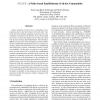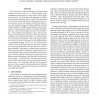1677 search results - page 227 / 336 » A distributed security scheme for ad hoc networks |
ACSAC
2004
IEEE
15 years 1 months ago
2004
IEEE
Ad-hoc networks are perceived as communities of autonomous devices that interconnect with each other. Typically, they have dynamic topologies and cannot rely on a continuous conne...
CISIS
2009
IEEE
15 years 4 months ago
2009
IEEE
— JXTA defines a set of six core protocols specifically suited for ad hoc, pervasive, multi-hop, peer-to-peer (P2P) computing. These protocols allow peers to cooperate and form...
84
Voted
DIALM
2004
ACM
15 years 3 months ago
2004
ACM
We present three localized techniques for broadcasting in large scale ad hoc networks, i.e., for the problem of disseminating a message from a source node to all the nodes in the ...
IEEEARES
2008
IEEE
15 years 4 months ago
2008
IEEE
Mobile Ad hoc Networks (MANETs) rely on dynamic configuration decisions to efficiently operate in a rapidly changing environment of limited resources. The ability of a MANET to ma...
GLOBECOM
2008
IEEE
14 years 11 months ago
2008
IEEE
— Nodes forming mobile ad hoc networks (MANET) nodes can be logically partitioned into 1) a selfish user agent serving the interests of the end user (owner) of the mobile device...


